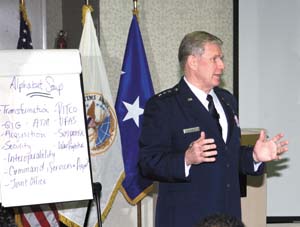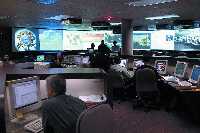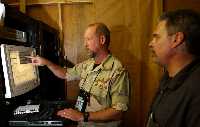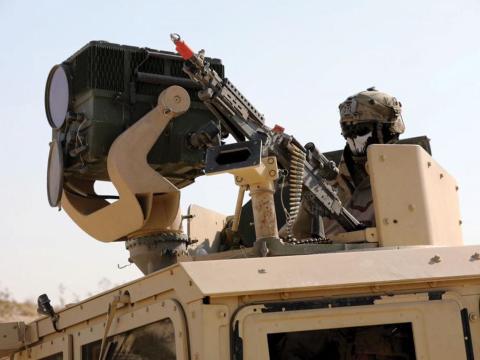Information Systems Agency Undergoes Organizational Overhaul
Lt. Gen. Harry D. Raduege Jr., USAF, director, Defense Information Systems Agency (DISA), says that organizational change is necessary to remain relevant.
Realignment focuses on business strategies. 
The U.S. Defense Department’s primary information technology support agency is doing its part for military transformation by undertaking a major reorganization. By overhauling its organizational structure, the Defense Information Systems Agency aims to maintain the high level of support to its customers that it has been providing in current operations and in the global war against terrorism. The reorganization will help the agency take advantage of opportunities in five areas and position it to become the department’s primary provider of end-to-end global network-centric solutions.
In June 2000, when Lt. Gen. Harry D. Raduege Jr., USAF, took over as director of the Defense Information Systems Agency (DISA), Arlington, Virginia, several military leaders expressed their confidence in his ability to address issues raised by critics of the agency. Since that time, Gen. Raduege has initiated a number of changes, including the creation of the agency’s first 500-day plan, which featured 140 action items (SIGNAL, November 2001, page 49) based on requirements identified by the leaders of the organizations it serves. The most recent reorganization reflects how DISA’s responsibilities in areas such as acquisition, engineering and operations have grown during the past several years (SIGNAL Connections, “DISA Reorganizes,” November 2003).
According to Gen. Raduege, the transformational actions that began in October 2003 were actually the third restructuring since he became DISA’s director. The first organizational change took place in October 2000. The agency realigned so it could become a one-stop shop for network services. This change was a relatively minor reorganization, but very significant, the general says, because it gave customers a single point of contact for network services.
DISA’s second overhaul was a natural progression from the first. The network services effort was successful; consequently, the next goal was to extend the customer-focus concept across the entire organization. To achieve this objective, the agency’s leaders developed the Global Information Grid (GIG) construct, which established six principal directors in the major areas that compose the GIG concept: interoperability, network services, customer advocacy, computing services, application engineering and operations. In October 2001, a revamped organizational structure was put into place to support this model.
Gen. Raduege relates that this second restructuring also was considered a success. However, because it was implemented within weeks of the terrorist attacks and DISA was called upon to meet the immediate needs of the military services, instituting some of the finer points of the plan had to be postponed.
“The construct and reorganization of October 2001 worked well for us for two years, but now, with our third reorganization, we are really a strategy-focused organization and have missions and opportunities before us. That’s why we have now come up with a construct that involves three principal directors in what we call strategic business units,” Gen. Raduege explains. These three represent a rearrangement of the people and organizational elements of the six principal directorates established in the October 2001 realignment. “It was not an evolution but a revolution in the way we reorganized,” he says.
The three directorates—GIG Enterprise Services (GES) Engineering, GIG Combat Support and GIG Operations—address the core of DISA’s missions. The GES Engineering unit is now responsible for developing and implementing end-to-end systems engineering solutions for the GIG. Fielding and sustaining network-centric products and services are the responsibility of the GIG Combat Support directorate. And the GIG Operations Directorate manages, operates and defends the infrastructure. All together, these directorates focus on DISA’s mission to support the full life cycle of technology provided to the warfighter and agencies—from acquisition through sustainment to support during operations.
Four shared services units, which also were formed by rearranging responsibilities, support the three directorates. For example, the new Strategic Planning and Information Directorate combines all of DISA’s former planning, programming and resources areas with the command information division and customer advocacy unit into one strategically focused area.
The Chief Financial Executive/ Comptroller also is now a shared services unit. Gen. Raduege explains that the formation of this unit is an indication of DISA’s increased emphasis on managing the agency’s financial affairs.
 |
DISA helps provide information assurance through its Global Network Operations and Security Center. |
DISA’s transformation is a mix of both evolutionary reforms from a mission standpoint and revolutionary efforts in terms of John P. Stenbit’s vision. Stenbit, assistant secretary of defense, networks and information integration (NII), envisions revolutionary approaches for providing network-centric enterprise services as well as for meeting Defense Department and warfighter needs. The former is a large effort DISA has assumed that will be the “big news of the future,” Gen. Raduege says. For the latter, DISA already has begun to deliver more bandwidth to approximately 100 Defense Department locations worldwide.
One example of the evolutionary nature of the reorganization is that the component acquisition executive (CAE) is now a full-time position. Under DISA’s former structure, Diann McCoy, CAE, carried out acquisition tasks, but she also had other responsibilities. “In describing it, DISA was probably more of a ‘little A’ than a ‘big A’ acquisition organization. Diann McCoy was our component acquisition executive prior to this change; however, at that time we were dealing with smaller scale but very significant acquisition activities compared to the large acquisitions that we are now involved in—for example, the GIG-Bandwidth Expansion (GIG-BE) initiative and the Net-Centric Enterprise Services. So this has been an area that is both evolutionary and revolutionary,” Gen. Raduege offers.
Under the new structure, McCoy reports directly to DISA’s director and has a full-time staff. She is responsible not only for the content or technical reviews of all of DISA’s programs but also for the program review materials. The general says that the change indicates the agency’s commitment to becoming a joint information technology acquisition organization for the Defense Department.
Gen. Raduege contends that DISA has been changing during the past several years for the same reason corporations have been changing: to remain relevant. He believes the agency is the crux between commercial information technology advances and Defense Department transformation efforts. He echoes the notion expressed by other military leaders that transformation is a continuous process, and as a result, DISA must continue to examine its structure and make adjustments, he says.
“There have been huge efforts in Defense Department transformation, and there are huge efforts in industry. To keep those in balance, we almost become the fulcrum trying to balance out the efforts. Certainly, warfighters’ needs are very important, and warfighters these days are asking for more and more bandwidth. They’re asking for it in underprivileged parts of the world that lack infrastructure. They’re asking for it to be quickly provided to them in large quantities, and this requirement for quickness demands a flexible acquisition strategy and acquisition organization,” the general states.
As a result of the reorganization, DISA may be able to meet the demands of warfighters and agencies more quickly, but at the same time, DISA’s expectations of industry will be higher as it looks to companies to deliver solutions faster. Agency personnel will visit corporate laboratories to see demonstrations of the technologies to ensure that they work as promised. This will allow DISA personnel to discover problems promptly. And although DISA is interested in knowing what capabilities can be delivered immediately, agency personnel also will want to hear technologists’ predictions about next-generation capabilities.
“This is good. This is breaking down any barriers that were perceived or actually there between DISA and industry. We need to talk. We need to partner. We need to develop new relationships for sharing information about product lines, needs and requirements versus what can be delivered,” the general says.
Gen. Raduege admits that the overhaul the agency has undergone during the past several years has posed tremendous challenges. The top-to-bottom organizational realignment has meant not only relocating personnel but also redefining responsibilities. However, the reorganization ultimately will benefit employees and service personnel assigned to the agency as well. A work force plan has been developed based on a concept called home teaming. Each team has a “champion” who monitors the agency’s progress in terms of meeting goals and achieving the vision. Professional development of the personnel is continuous so that growth is achieved in required specialty areas. A career path is constructed for each employee that includes the progress the individual has made on that path. Using a pyramid approach, DISA is determining how it can help employees develop professionally on that path within the agency. “So, we’re really changing DISA and moving it toward a knowledge-based work force with a specific plan so we can follow our progress, and we have specific goals and objectives to achieve for ourselves,” the general says.
This latest reorganization takes advantage of opportunities in acquisition, engineering, operations, finance and governance. These are not new areas for DISA, but Gen. Raduege relates that the agency will be involved in them in larger ways. To emphasize this point to agency personnel, the general says he labeled them Big A, Big E, Big O, Big F and Big G.
“DISA has always been an acquisition organization. Things like the spiral development of the Global Command and Control System, the Global Combat Support System, the Defense Message System, teleports are all major acquisitions, and we had always done those. However, with Mr. Stenbit’s vision of larger enterprise services and big bandwidth through GIG-BE and through Net-Centric Enterprise Services, if we were going to be able to take on those kinds of major acquisitions, we were going to have to change our emphasis and our organization to be able to handle that.
“We also wanted to become a joint information technology acquisition organization, so that when people want to buy joint information technology in the future they can come to us and we should have the contracts, the capabilities, the speed to be able to address those kinds of concerns,” he explains.
The Big E reflects DISA’s larger role in engineering. The new responsibilities of the GIG extend the agency’s work on the Defense Information System Network to offering services of end-to-end system engineering across the GIG and the GIG Enterprise Services. “So really, end-to-end system engineering goes from the foxhole to the cockpit to the large command centers right into the White House to the commander in chief,” Gen. Raduege says.
Operations is the Big O. The general points out that one of the U.S. Strategic Command’s newest responsibilities is operating the GIG, so a renewed relationship is being formed between the command and DISA. “We’re looking at a new arrangement where we will actually elevate and expand what DISA’s involvement is in allowing Adm. Ellis, the combatant commander, to put his arms around operating, managing and defending the entire Global Information Grid,” he says.
|
Information technology systems have been critical to operations in Afghanistan and Iraq. Rick Henderson (l), network integrator from Shaw Air Force Base, discusses the new systems management service (SMS) with Anthony Coscione, systems administrator, 447th Expeditionary Communications Squadron at Baghdad International Airport. The SMS will allow the Network Control Center to configure and remotely install software packages on any workstation in its network.
|
The financial area is the Big F. Although DISA has always managed its own finances, the reorganization refocuses attention on this area. The realignment includes new lines of accountability, Gen. Raduege says, that hold DISA’s director and chief financial executive accountable and responsible for knowing how and where monies are being spent. This will allow for better management, he adds.
Governance is the Big G. The Defense Department has introduced a new way for agencies to account for their activities. Called the balanced score card, it involves aligning an organization toward a corporate strategy and strategic goals. DISA will focus on customers, finances, learning and growth of the work force, and improving internal processes. “Our organization’s success will be measured based on how we meet our goals, objectives and strategies,” the general says.
“The changes that we have made have been very important for us, and I think we have been successful. We have had success in supporting the global war on terrorism, operation Nobel Eagle, operation Enduring Freedom and operation Iraqi Freedom. Those are a lot of combat operations that DISA, as a combat support agency, has been able to stand up to and meet the demands of our deploying forces,” Gen. Raduege says. This success has led to new responsibilities, which are driving the demand for a new organizational construct, he adds.
| Plan the Work, Work the Plan After completing or setting in motion work on the vast majority of the items in its first 500-day plan, the Defense Information Systems Agency hit the ground running on new requests from combatant commanders and U.S. Defense Department agencies. Its second 500-day plan focuses on capabilities that support combat operations as well as other missions. Lt. Gen. Harry D. Raduege Jr., USAF, recognized the need to transform the agency into a customer-centric organization as soon as he became the director of the Defense Information Systems Agency (DISA) in June 2000. To achieve this goal, the general communicated with the combatant commanders at each of the unified commands and heads of Defense Department agencies to open the lines of communication. He then instituted a strategy that he first employed at U.S. Central Command in 1996: a 500-day plan. Based on requirements identified by military leaders, Gen. Raduege and DISA staff produced the first plan that included 140 items. The approach was a success and led to the second plan, introduced in 2003 and set to be completed by the end of this year. In his “Director’s Intent” statement at the beginning of the plan, Gen. Raduege indicates that he is well aware of the overall needs of DISA’s customers. He identifies nearly a dozen initiatives that will benefit the entire Defense Department. Among them are the Global Command and Control System, the Global Information Grid-Bandwidth Expansion (GIG-BE) initiative, network-centric enterprise services, network operations, wireless technologies and information assurance. In addition, DISA is joining forces with the White House Communications Agency to modernize and improve communications capabilities for the commander in chief. A review of the current strategy, “DISA 2004: A 500-Day Action Plan for Implementing Joint C2 and Information Integration,” reveals that by far the GIG-BE initiative and the Teleport program need to continue to move out and move out quickly. Referring to the GIG-BE, the combatant commander at one unified command said, “We need this capability now!” Leaders at several organizations specifically identified these efforts as priorities, and others, while not singling out the GIG-BE or teleports, emphasized the need for more bandwidth. Information security and information assurance also rank high on the list of action items in the plan. Among the capabilities that many commands and defense agencies are seeking are solutions in the areas of intrusion detection, network monitoring, information flow for data assurance and public key infrastructure. Requests for work on interoperability solutions reflect the changing nature of the U.S. military as well as current operations. Several leaders identified the need for improved interoperability in both the joint and coalition environments. Technologies that would improve information sharing also are a priority for many commands and agencies. From the perspective of the unified combatant commander, these capabilities would enhance situational awareness and battle management during joint and coalition operations. Intelligence community leaders are interested in the networking technologies that would support information flow among agencies and would address the issue of information dissemination between different security levels. The 500-Day Plan is a road map rather than a wish list. Gen. Raduege emphasizes that individual items within the plan are tracked, and program and project reviews occur regularly to assess progress. “This is our way of staying in contact with our customers because it’s a give-and-take all the time. It’s sort of bold of us to actually listen to customers and take their letters of their input and write that input down and say, ‘Judge us on our ability to deliver.’ It’s a contract. It’s a way of committing ourselves to our customers instead of listening to their concerns, writing them down and perhaps forgetting them or thinking they are too hard to achieve. “So, we’re giving constant feedback to our customers. ‘Here’s where we are. Here’s where we stand. Here are the problems we’re experiencing. Here’s how you can help us.’ Or we tell them how we take problems up the chain of command so that we can truly meet the needs of the combatant commanders, services and agencies—our true customers. This is customer-focused organization,” Gen. Raduege states. |




